A questo proposito va notato che così come Bly non fu la prima donna americana a diventare reporter, ella non fu neanche la prima donna a fare il giro del mondo da sola; ma in entrambi i casi introdusse in tali ambiti delle novità che ne trasformarono le precedenti modalità e resero unica la sua esperienza. Nel caso del viaggio intorno al mondo, Bly fu la prima donna a fare una corsa contro il tempo che, combinando il tema della velocità - legato al progresso tecnico - con quello della trasgressione, risultò particolarmente attraente agli occhi del pubblico americano; inoltre la grande pubblicità data all'evento dal quotidiano che lo sponsorizzava contribuì al successo strepitoso dell'impresa. (Scatamacchia, 2002)

Bly, Nellie. Around the World in Seventy-Two Days. New York: The Pictorial Weeklies Company, 1890.
Around the World in Seventy-Two Days is a book by journalist Elizabeth Jane Cochrane, writing under her pseudonym, Nellie Bly. The chronicle details her 72-day trip around the world, which was inspired by the book, Around the World in Eighty Days by Jules Verne. She carried out the journey for Joseph Pulitzer's tabloid newspaper, the New York World.

.jpg)